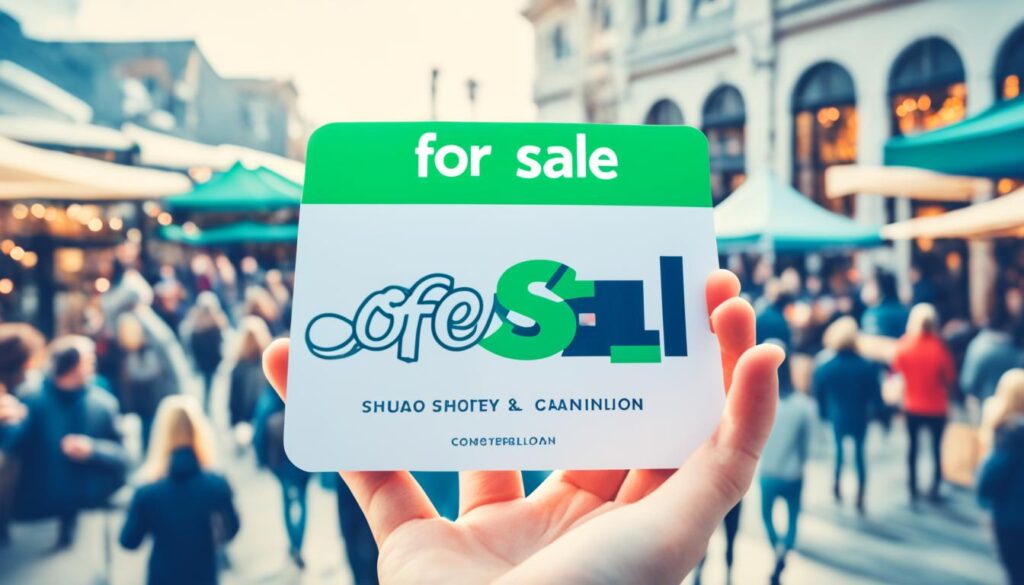Selling your Shopify store can be a profitable transition to new endeavors. Whether you’re looking to start a new business or focus on personal matters, selling your online store can provide the financial means to pursue your next passion. A business broker can be instrumental in facilitating the sale of your business online, acting as a middleman to leverage their expertise and buyer contacts for the best sale price. In this article, we’ll explore the steps you must take to successfully sell your Shopify store and maximize its value.
Selling a Shopify store is part of the larger category of selling online businesses, which requires careful preparation and understanding of the value your ecommerce store brings to potential buyers.
By the end of this guide, you’ll have a clearer understanding of selling online businesses, including how to prepare your Shopify store for sale to attract the right buyers and secure the best possible deal.
Key Takeaways:
- Before selling, ensure your store is up-to-date and conduct a business valuation, considering the monthly net profit as a key factor in determining the store’s value.
- List your store for sale on third-party online marketplaces to find potential buyers.
- Transfer ownership of your store in the Shopify admin once you’ve found a buyer.
- Consider your goals and motivations before deciding to sell your Shopify business.
- The valuation of your store depends on factors such as growth rate, profitability, brand strength, and the 12-month average of monthly net profit.
Preparations for Selling Your Shopify Store
Before selling your Shopify store, it’s crucial to make certain preparations to ensure a smooth and successful sale. By taking the following steps, you can maximize the value of your store and facilitate the transfer of ownership:
- Identify the data you need to retain
- It’s essential to have Google Analytics installed on your website. This tool is crucial for providing traffic data and verifying the financial history of your business, which can significantly enhance the credibility of your store to buyers.
Create a transition plan that includes transferring social media accounts to the new owner as part of the asset transfer process. This ensures that all aspects of the business’s online presence are seamlessly handed over, maintaining continuity and value.
1. Ensure your store is up-to-date
Before putting your store up for sale, ensure all your products, inventory, and information are up-to-date. This includes updating product descriptions, images, and prices and ensuring that your store’s design is current and visually appealing.
2. Evaluate the value of your business
Before setting a price for your store, conducting a thorough business valuation is important. This will help you determine its worth and ensure that you receive fair compensation for your hard work and investment. Consider factors such as revenue, profit margins, customer base, brand reputation, and growth potential when evaluating the value of your business.
3. Identify the Data You Need to Retain for Potential Buyers
Before transferring ownership of your store, identify the data that you need to retain for your records or future use. This may include customer information, sales data, marketing materials, and other assets essential for your business operations.
4. Consider existing contracts or obligations
Take into account any existing contracts or obligations that may be impacted by the sale of your store. Consult with legal professionals if necessary to ensure that the transfer of ownership complies with any contractual agreements or legal requirements.
5. Create a transition plan
Develop a comprehensive plan to facilitate a smooth transition of your business to the new owner. This includes creating a timeline for onboarding, providing training and support, and transferring any necessary access credentials or licenses.
By taking these preparations seriously, you can ensure a seamless selling process and increase the likelihood of a successful sale. Remember to seek professional advice when necessary to navigate any legal or financial complexities that may arise.
“Success is not the key to happiness. Happiness is the key to success. If you love what you are doing, you will be successful.” – Albert Schweitzer
Where to Sell Your Store
As a Shopify or ecommerce store owner, you can sell your store on third-party online business marketplaces. These platforms provide a wide range of potential buyers for your ecommerce business. By listing your store on these marketplaces, you can reach a larger audience and increase your chances of finding the perfect buyer.
Some popular online business marketplaces where you can sell your Shopify store include:
- Flippa
- Business Exits
- Acquire.com
Each marketplace has its requirements and steps for listing your store. Review the guidelines and follow the listing process carefully to ensure a successful sale.
When selling your store on a third-party marketplace, it’s important to prioritize legal considerations. It is highly recommended that you contact a legal professional to draft a contract of sale that protects your interests and ensures a smooth transaction.

By leveraging the reach and resources of online business marketplaces, you can find buyers for your ecommerce business and maximize your chances of a successful sale.
Transfer Ownership of Your Shopify Store
To ensure a smooth sale process, it’s crucial to communicate clearly with interested buyers about the steps for transferring ownership and taking over inventory management. Once you have found a buyer and both parties have agreed to the terms of the sale, it’s time to transfer ownership of your Shopify store. This process involves updating various aspects of your store and ensuring a smooth transition for the new owner.
Updating Contact Information and Notification Details
Firstly, you’ll need to update your store’s contact information. This includes providing the name, email address, and phone number for the new Shopify store owners. Ensuring that the store’s contact details are accurate and up-to-date is crucial to avoid any miscommunication or confusion after transferring.
Additionally, you need to update the store’s notification information. This includes setting up email addresses where order confirmations, shipping updates, and other important notifications will be sent. Provide the new owner’s preferred email addresses and configure the settings accordingly.
Transferring Domain Ownership
If you have purchased custom domains for your Shopify store, transferring the domain ownership to the new owner is essential. This ensures they have full control over the domains associated with the store. The specific process of transferring domain ownership may vary depending on the domain registrar used, but generally, it involves initiating a domain transfer and following the registrar’s instructions.
Don’t forget to inform the new owner about any renewal dates for the domains and clarify their domain management responsibilities once the transfer is complete.
Updating Billing and Payout Information
Next, you should update the billing information associated with your Shopify store. This includes providing the new owner’s payment details for recurring charges, such as monthly subscription fees or app payments.
In addition, you’ll need to update the store’s payout information to ensure the new owner receives payments correctly. Specify the new owner’s bank account details or preferred payment method for payouts so they can start receiving the store’s revenue without interruptions.
Transferring Account Ownership
The final step in transferring ownership is officially transferring the Shopify account ownership to the new owner. This process restricts certain permissions in the Shopify admin, safeguarding the store’s data and settings.
Transferring account ownership ensures the new owner has full control over the store and can make necessary changes and updates. To ensure a seamless transition, following Shopify’s guidelines and procedures for transferring account ownership is crucial.
Now that you’ve successfully transferred ownership of your Shopify store, the new owner can take the reins and continue running the business. Remember to provide them with any necessary documentation or resources to assist them in managing the store effectively.
Steps to Transfer Ownership of Your Shopify Store 1. Update contact information and notification details. 2. Transfer domain ownership if applicable. 3. Update billing and payout information. 4. Transfer Shopify account ownership.
Should I Sell My Shopify Business?
Deciding to sell your Shopify business is a strategic choice that requires careful consideration of your goals and motivations. While each individual’s circumstances are unique, there are common reasons why entrepreneurs decide to sell their ecommerce business. Some of these reasons include:
- Wanting to start a new business venture
- Transitioning focus to personal matters or family commitments
- Exploring new hobbies or interests
Timing is also a crucial factor when deciding to sell your online store. While selling when your business is thriving can maximize your profit, there are still opportunities to sell even if your business is experiencing seasonal fluctuations or a slight decline. The key is to analyze the market, evaluate your business’s potential, and determine the right moment to make a move.
“The timing of selling your online store is instrumental in achieving a good price. Even in challenging times, there are buyers looking for opportunities.” – Ecommerce Expert
Assessing your goals, motivations, and market trends can help you decide when to sell your Shopify business.
How Much Can I Sell My Shopify Store For?
Determining your Shopify store’s value is crucial when selling it. The valuation of a Shopify store depends on several factors, including its growth rate, profitability, and brand strength. To estimate the value of an ecommerce business like yours, common valuation methods such as discounted cash flow (DCF) and earnings multiplier are used. Business brokers often employ these and other methods, such as the trailing twelve-month average and monthly average, to calculate the value of a business for potential buyers, emphasizing the importance of accurate valuation in achieving a higher-profit exit.
Factors Affecting Business Value:
- Business model
- Revenue stream diversity
- Growth rate
- Customer lifetime value
- Assets
These factors play a significant role in determining the value of your Shopify store. For instance, a well-diversified revenue stream and a high growth rate can lead to a higher valuation.

Shopify Store Pricing Methods:
- Discounted Cash Flow (DCF): This method estimates the present value of your store’s future cash flows by considering projected revenue, expenses, and discount rates. It provides a comprehensive view of your store’s potential profitability. Business brokers frequently utilize DCF, among other methodologies, to ensure a comprehensive valuation.
- Earnings Multiplier: This method calculates the value of your store by multiplying its earnings over a certain period by a predetermined multiple. The multiple is based on industry standards and reflects the perceived risk and market conditions. Business brokers leverage this method to align the valuation with market expectations and potential buyer interest.
Using these valuation methods, you can better understand your Shopify store’s worth in the market. However, it’s important to note that the final selling price may also depend on the negotiation between you and the potential buyer.
OpenStore’s Pricing Model:
OpenStore takes a highly data-driven approach to evaluating Shopify stores. They provide a free valuation service that analyzes the key metrics of your store and compares them to industry benchmarks. Their comprehensive analysis helps you understand the strengths and weaknesses of your business, allowing you to make informed decisions when pricing your store for sale. The value of a Shopify store is not solely determined by its financial performance but by factors such as its future potential, customer loyalty, and market demand. A thorough evaluation using reliable valuation methods combined with industry expertise is essential for accurately assessing your store’s worth.
Factors Affecting Valuation
| Factors | Description |
|---|---|
| Business Model | The structure and strategy of your business, including its scalability and potential for growth. |
| Revenue Stream Diversity | The variety and stability of your revenue sources, minimizing dependence on a single stream. |
| Growth Rate | The long-term value derived from each customer reflects the strength of your customer base. |
| Customer Lifetime Value | Your business’s tangible and intangible assets, such as intellectual property, inventory, and customer databases. |
| Assets | The tangible and intangible assets that your business possesses, such as intellectual property, inventory, and customer databases. |
Conclusion
Selling your Shopify store can be a strategic move to pursue new opportunities and achieve financial freedom. By carefully preparing your store, finding the right marketplace, and transferring ownership correctly, you can maximize the value of your business and ensure a smooth transition.
Timing is crucial when selling your Shopify store. Consider factors such as your business’s current performance, market trends, and personal circumstances. Selling your store when it is in a strong position can help you fetch a higher price.
Valuation methods play a significant role in determining the worth of your Shopify store. Factors such as revenue, growth rate, customer profiles, and brand strength all impact the value. Consulting with valuation experts, like OpenStore, can provide reliable information and help you understand your business’s true worth.
When you sell your Shopify store, you open up new possibilities for your future. Whether you want to start a new venture, pursue other personal interests, or simply enjoy the fruits of your labor, selling your Shopify store can provide the financial means to achieve your next passion.
FAQ
How do I sell my Shopify store?
What preparations should I make before selling my store?
Where can I sell my Shopify store?
How do I transfer ownership of my Shopify store?
Should I sell my Shopify business?
How much can I sell my Shopify store for?
What is the conclusion about selling a Shopify store?
FAQ
How do I sell my Shopify store?
To sell your Shopify store, you should ensure your store is up-to-date, conduct a business valuation, and identify the data you need to retain. You can then list your store for sale on third-party online marketplaces like Flippa, Business Exits, and Acquire.com. Once you find a buyer, you can transfer ownership of your store in the Shopify admin.
What preparations should I make before selling my store?
Before selling your store, you should ensure your store is up-to-date, conduct a business valuation, and identify the data you need to retain. You should also consider any existing contracts or obligations that may be impacted by the sale. Additionally, create a plan to transition your business to the new owner, including a timeline for the onboarding process.
Where can I sell my Shopify store?
As a Shopify store owner, you must sell your store independently from the Shopify platform. You can list your store for sale on third-party online business marketplaces such as Flippa, Business Exits, and Acquire.com. Each marketplace has different requirements and steps for listing your store.
How do I transfer ownership of my Shopify store?
Once you have found a buyer and agreed to the terms of the sale, you can transfer ownership of your Shopify store in the Shopify admin. This includes updating your store’s contact information, notification information, and any custom domains you’ve purchased. You should also update the billing information and store payout information to the new owner’s details. Finally, you need to officially transfer account ownership to the new owner, which restricts certain permissions in the Shopify admin.
Should I sell my Shopify business?
Deciding to sell your Shopify business is a personal decision that should consider your goals and motivations. Common reasons for selling include wanting to start a new business, focusing on personal matters, or pursuing a new hobby. The timing of selling your online store is also important to consider.
How much can I sell my Shopify store for?
The value of your Shopify store is determined by various factors, including its growth rate, profitability, and brand strength. Valuation methods such as discounted cash flow (DCF) and earnings multiplier are commonly used to estimate the value of an ecommerce business. Factors that impact valuation include the business model, revenue stream diversity, growth rate, customer lifetime value, and assets.
What is the conclusion about selling a Shopify store?
Selling your Shopify store can be a strategic move to pursue new opportunities. By making preparations, finding the right marketplace, and transferring ownership correctly, you can maximize the value of your business and ensure a smooth transition. Consider the timing, valuation methods, and factors that impact business value when selling your Shopify store.






